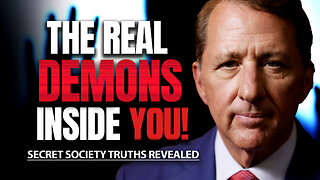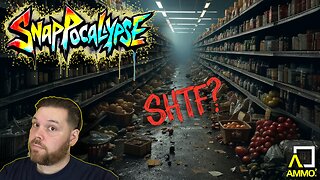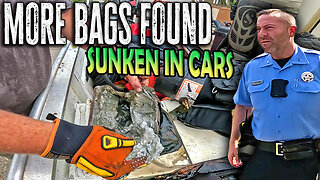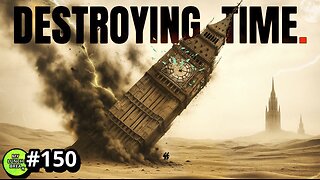Premium Only Content

The Shadow: Tenor with a Broken Voice (June 5, 1938)
Setting: A contemporary (1938) American city, likely New York, with scenes in a grand opera house, backstage dressing rooms, city streets, and a criminal hideout. The episode uses sound effects like operatic singing, footsteps, creaking doors, gunfire, and eerie whispers to create a dramatic, theatrical atmosphere, blending high culture with noir crime.
Plot:
Introduction: The episode opens with the iconic The Shadow theme, an excerpt from Camille Saint-Saëns’ Le Rouet d’Omphale, followed by announcer Frank Readick’s chilling delivery: “Who knows what evil lurks in the hearts of men? The Shadow knows!” The narrator introduces “Tenor with a Broken Voice,” a tale of intrigue centered on a once-great opera singer whose career and life are threatened by crime.
The Premise: The story focuses on a renowned tenor, possibly named Enrico or Antonio, whose voice has mysteriously deteriorated, earning him the moniker “Tenor with a Broken Voice.” His career in ruins, he faces financial desperation or blackmail, drawing the attention of Lamont Cranston and Margo Lane. The tenor’s plight is tied to a criminal plot—perhaps a mobster’s scheme to extort him, a rival’s sabotage, or a theft of valuable opera-related artifacts (e.g., a jeweled prop). The “broken voice” might result from poison, psychological torment, or a supernatural curse, aligning with The Shadow’s pulp sensibilities.
The Investigation: Cranston, using his dual identity, investigates the opera world, mingling with singers, managers, and stagehands, while The Shadow employs his invisibility and hypnotic powers to uncover the truth. Margo Lane assists, possibly posing as a patron or journalist to gather intel backstage. The investigation reveals a criminal mastermind—perhaps a corrupt impresario or a gangster—exploiting the tenor’s vulnerability. Key scenes include The Shadow eavesdropping in a darkened theater, thwarting an attack on the tenor, or interrogating a nervous accomplice, with sound effects like arias, slamming doors, or muffled cries.
Escalating Action: The criminal’s scheme escalates, possibly involving a plan to ruin the tenor’s comeback performance or steal a fortune during an opera gala. The Shadow’s interventions lead to chases through city streets or confrontations in the opera house’s catacombs, with the tenor’s emotional struggle—his fear of losing his voice forever—adding depth. Margo might uncover a clue, such as a poisoned drink or a threatening note, while Cranston navigates police involvement, possibly via Commissioner Weston.
Climax and Resolution: The climax likely occurs during a high-stakes opera performance, where The Shadow foils the criminal’s plan—perhaps preventing a murder or recovering stolen goods. Using his mental powers, he exposes the mastermind, who might be arrested or meet a fatal end. The tenor, restored to confidence or miraculously recovering his voice, delivers a triumphant aria, symbolizing redemption. The episode concludes with Cranston and Margo reflecting on the case, and Readick’s haunting laugh teasing the next adventure, reinforcing The Shadow’s mystique.
Themes: The redemption of the fallen, the fight against exploitation, and the power of unseen justice. The episode blends The Shadow’s pulp roots with operatic drama, reflecting 1930s fascination with high art and crime.
Cast and Roles:
The Shadow/Lamont Cranston: Played by Orson Welles, delivering a dual performance—suave as Cranston, commanding as The Shadow—with his rich, theatrical voice enhancing the character’s enigmatic presence.
Margo Lane: Played by Margot Stevenson, portraying Cranston’s companion with intelligence and elegance, voiced with poise and determination, possibly aiding through undercover work or emotional insight.
The Tenor: Played by an unnamed actor, likely a radio veteran, voicing the tormented singer with a mix of pathos and passion, evoking a fallen star struggling to reclaim his glory.
The Criminal Mastermind: Played by an unnamed actor, depicting a cunning villain—perhaps a mobster or impresario—with a sinister, calculating tone.
Supporting Characters: Unnamed ensemble actors, including:
Henchmen: Voiced as gritty thugs carrying out the villain’s orders.
Opera Personnel: Stagehands, managers, or rival singers, voiced with theatrical flair or fear.
Commissioner Weston (Possible): Voiced as a skeptical police official, if featured, interacting with Cranston.
Announcer/Narrator: Frank Readick, delivering the opening and closing lines, including “The Shadow knows!” with a chilling, echoed effect, framing the story’s suspense.
Note on Cast: The Shadow relied on a skilled radio cast, with Welles and Stevenson as leads, supported by actors doubling in minor roles. Welles’s Mercury Theatre background brought cinematic intensity to the pulp drama.
Production Details:
Music: The theme, an excerpt from Saint-Saëns’ Le Rouet d’Omphale, opens and closes the episode, with incidental music—possibly operatic excerpts or suspenseful stings—accentuating drama, composed by Mutual’s in-house musicians.
Writer: Likely Walter B. Gibson or Edward Hale Bierstadt, crafting a story rooted in The Shadow’s pulp origins, blending mystery, crime, and theatrical flair.
Director: Likely overseen by the Mercury Theatre team, with Welles’s influence ensuring a dynamic, cinematic production.
Sound Effects: Critical to the episode, including operatic singing, footsteps, creaking doors, gunfire, and whispers, creating a vivid, theatrical soundscape. The Shadow’s invisibility might be suggested by sudden silences or distorted voices.
Sponsor: Blue Coal, a heating company, sponsored the 1937–1938 season, with brief ads integrated into the Sunday evening broadcast, typically at 5:30 PM Eastern.
World and National Events Around June 5, 1938:
To provide context for the broadcast, here are key world and national events occurring in early June 1938, reflecting the pre-war climate that shaped listeners’ perspectives:
World Events:
Nazi Germany’s Expansion: Germany, under Hitler, annexed Austria in the Anschluss (March 12, 1938) and was increasing pressure on Czechoslovakia’s Sudetenland, heightening European tensions. Radio news reported fears of war, with the Munich Agreement looming (September 1938), resonating with the episode’s theme of unseen threats, similar to Lights Out’s horror narratives.
Japanese Invasion of China: Japan’s Second Sino-Japanese War continued, with the Battle of Xuzhou (ending May 1938) securing Japanese gains and leading to civilian atrocities. U.S. radio covered humanitarian concerns, amplifying anti-Axis sentiment, paralleling The Shadow’s fight against evil.
Italian Fascism: Mussolini’s Italy, aligned with Germany, maintained its imperialist stance post-Ethiopia (1936), with negotiations for the Pact of Steel (signed May 1939) underway. U.S. media reported Axis aggression, echoing the episode’s battle against a cunning villain.
Holocaust Escalation: Nazi anti-Jewish policies intensified, with increased persecution and emigration pressures. Kristallnacht (November 1938) loomed, with limited U.S. awareness via radio, aligning with the episode’s dark tone.
National Events:
Economic Challenges: The U.S. was navigating the “Roosevelt Recession” (1937–1938), with unemployment at 19%. New Deal programs, like the Wagner Act, supported labor, covered in radio news, reflecting public desire for stability, akin to The Shadow’s restoration of order.
Roosevelt’s Policies: President Franklin D. Roosevelt pushed economic recovery and neutrality, with the Fair Labor Standards Act (passed June 25, 1938) setting a minimum wage and 44-hour workweek. Radio addresses emphasized democratic values, contrasting with the episode’s criminal chaos.
Entertainment and Morale: Hollywood and radio thrived, with films like Snow White and the Seven Dwarfs (1937) and radio shows like The Lone Ranger dominating. The Shadow’s pulp-inspired drama, airing Sundays, offered escapism amid economic and global woes.
Sports and Culture: The 1938 MLB season featured the New York Yankees, with Joe DiMaggio excelling. Benny Goodman’s swing music, like “Sing, Sing, Sing,” defined the era’s vibrant culture, covered on radio.
-
 14:05
14:05
Sideserf Cake Studio
16 hours ago $7.32 earnedHYPERREALISTIC HAND CAKE GLOW-UP (Old vs. New) 💅
32.2K5 -
 28:37
28:37
marcushouse
18 hours ago $2.64 earnedSpaceX Just Dropped the Biggest Starship Lander Update in Years! 🤯
11.5K5 -
 14:54
14:54
The Kevin Trudeau Show Limitless
3 days agoThe Hidden Force Running Your Life
81K15 -
 DVR
DVR
DLDAfterDark
5 hours agoIs The "SnapPocalypse" A Real Concern? Are You Prepared For SHTF? What Are Some Considerations?
9.43K6 -
 19:58
19:58
TampaAerialMedia
16 hours ago $0.32 earnedKEY LARGO - Florida Keys Part 1 - Snorkeling, Restaurants,
17.7K12 -
 1:23
1:23
Memology 101
2 days ago $0.83 earnedFar-left ghoul wants conservatives DEAD, warns Dems to get on board or THEY ARE NEXT
17K52 -
 3:27:27
3:27:27
SavageJayGatsby
6 hours ago🔥🌶️ Spicy Saturday – BITE Edition! 🌶️🔥
48.7K4 -
 26:09
26:09
Exploring With Nug
16 hours ago $11.02 earned13 Cold Cases in New Orleans What We Discovered Beneath the Surface!
47.5K17 -
 27:39
27:39
MYLUNCHBREAK CHANNEL PAGE
11 hours agoDestroying Time.
130K34 -
 3:27:19
3:27:19
Mally_Mouse
6 hours ago🌶️ 🥵Spicy BITE Saturday!! 🥵🌶️- Let's Play: Minecraft Christmas Adventure!!
130K7